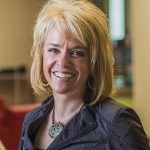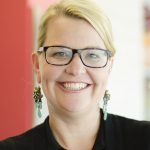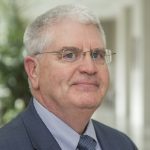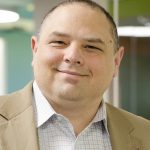
OSF Innovation looks back at successful second year
Year two is in the books for OSF Innovation and the act of collaborating across disciplines to solve complex health care problems has become old hat for those on the third and fourth floor of the Jump Trading Simulation & Education Center.
There’s not a day that goes by where I don’t see members of Performance Improvement (PI), Complex Innovation Solutions (CSI), Healthcare Analytics, Jump Simulation (Jump), OSF Partnerships, OSF Ventures and TeleHealth Services working on various projects together in rooms spread throughout the facility. Even the marketing team gets a chance to weigh in on some of the larger initiatives taking place.
Many of these developments will take time to flesh out. In the meantime, our teams in the OSF Innovation space continue to work on discipline-specific projects, many of which have experienced successes over the last year. Our seven OSF Innovation leaders share some of their greatest achievements in 2017 and visions for the future.
Becky Buchen, Senior Vice President of OSF Innovation
 Now that our divisions within OSF Innovation understand and have experienced what it’s like to work as a team, we’ve established a framework to make improvements in the clinical environment, specifically focusing on identifying sepsis sooner and advancing our cardiovascular and neurological services. This work is being led by the newly developed Solution Design and Integration team, a multidisciplinary group made up of employees from PI, patient experience, clinical education, clinical practice, clinical integration and healthcare analytics. The goal of this team is simple: come into work every day in a common environment and stay focused on a particular challenge for up to 20 business days, using design-thinking, innovation, PI and agile tools until a solution is developed.
Now that our divisions within OSF Innovation understand and have experienced what it’s like to work as a team, we’ve established a framework to make improvements in the clinical environment, specifically focusing on identifying sepsis sooner and advancing our cardiovascular and neurological services. This work is being led by the newly developed Solution Design and Integration team, a multidisciplinary group made up of employees from PI, patient experience, clinical education, clinical practice, clinical integration and healthcare analytics. The goal of this team is simple: come into work every day in a common environment and stay focused on a particular challenge for up to 20 business days, using design-thinking, innovation, PI and agile tools until a solution is developed.
We are also excited to soon announce how OSF Innovation will be supporting ideas generated by our own staff members. We’ve been working for the past couple of years to develop an intake and infrastructure mechanism to help vet ideas and help entrepreneurs take their ideas from concept, through maturity and to commercialization.
As we move into our third year, we want to continue working collaboratively while streamlining the time it takes to come up with solutions. We are also working to launch an executive innovation council that will provide key executive leaders across the Ministry a better understanding of the projects taking place within OSF Innovation. The idea is to help Mission Partners understand we are partners in solving health care problems and in building the culture of innovation.
Sarah de Ramirez, MD, Chief Medical Officer of Clinical Innovation and Vice President of OSF Innovation
 In 2017, OSF Innovation created the Complex Solutions Innovation or CSI team, a multidisciplinary group charged with identifying and designing solutions to reach the most vulnerable populations across the Ministry. Focusing on the elderly, rural and poor—our team, over the last year, developed an infrastructure around community-based health innovation that engages community members as partners towards influencing population health.
In 2017, OSF Innovation created the Complex Solutions Innovation or CSI team, a multidisciplinary group charged with identifying and designing solutions to reach the most vulnerable populations across the Ministry. Focusing on the elderly, rural and poor—our team, over the last year, developed an infrastructure around community-based health innovation that engages community members as partners towards influencing population health.
Through random forest modeling and with the guidance of expert panels, CSI has narrowed the list of issues the team will solve for that most commonly impact the health of our focus populations in three communities: Monmouth, Peoria and Pontiac. These seven determinants of health guide our solution-sourcing phase of work using internal and external innovation, invention, business and academic partnerships and community-based population partnerships.
As we move through the rest of 2018 and into 2019, we are working with the University of Illinois at Chicago Innovation Center and the Discovery Partners Institute (DPI), an interdisciplinary research hub led by the University of Illinois System to foster economic development through innovation. This partnership means faculty and students will help OSF Innovation prototype innovative health care solutions around social isolation and bringing the community health worker concept into the 21st century.
Simultaneously, we will also be executing partnerships with new startup companies to address food, transportation and mental health, and tailor these solutions to our most vulnerable populations. This collaborative approach allows OSF HealthCare to rapidly research and deploy solution sets around specific challenges in our focus area populations.
Suzanne Hinderliter, Vice President of Telehealth Services
 The Telehealth team has been busy over the last year developing, expanding and implementing a variety of programs across the Ministry in areas that need it the most, including TeleNeurology, TeleNeonatology, TeleNICU, TeleBehavioral Health, TeleDementia, TeleSkilled Nursing Facility and TeleLactation. The eICU program is now in all of our hospital facilities in Illinois that have Intensive Care Units and we’ve added more specialists who can provide asynchronous e-consults to other physicians through Epic, our Electronic Medical Record.
The Telehealth team has been busy over the last year developing, expanding and implementing a variety of programs across the Ministry in areas that need it the most, including TeleNeurology, TeleNeonatology, TeleNICU, TeleBehavioral Health, TeleDementia, TeleSkilled Nursing Facility and TeleLactation. The eICU program is now in all of our hospital facilities in Illinois that have Intensive Care Units and we’ve added more specialists who can provide asynchronous e-consults to other physicians through Epic, our Electronic Medical Record.
We’ve expanded the use of HealthLoop, a digital tool that sends prompts to patients that continuously guide and educate them before and after a procedure. The mobile application was initially piloted on patients who’ve gone through back and spine surgery in Peoria with much success. It’s now being used in Ottawa and Streator for patients who have undergone orthopedic surgeries. HealthLoop will soon be piloted at OSF HealthCare St. Joseph Medical Center for all discharged patients.
Telehealth Services has also adopted the new care management platform, Epharmix, to help patients stay engaged in their care through phone calls and text messages. The digital tool automates routine outreach to collect condition-specific, patient-reported outcomes so that clinicians can spot medical issues sooner. Our team has implemented changes within Epic to identify patients with sepsis sooner in the emergency department. We’ve also completed the strategy for a virtual care program that will cater to critical complex patients who are at high risk for hospital readmissions and are high utilizers of health care resources.
Mark Hohulin, Senior Vice President of Healthcare Analytics
 The ongoing cross-functional work of our team, Performance Improvement (PI) and all of the other groups within OSF Innovation has continued to improve and that’s led to all of us having a better understanding of what everyone is working on and how we support OSF Innovation for OSF HealthCare.
The ongoing cross-functional work of our team, Performance Improvement (PI) and all of the other groups within OSF Innovation has continued to improve and that’s led to all of us having a better understanding of what everyone is working on and how we support OSF Innovation for OSF HealthCare.
Healthcare Analytics, as a whole, has continued to grow its Advanced Analytics capabilities. We’ve used more statistical analysis in many of our projects over the past year in support of driving clinical decisions, needs and opportunities as well as monitoring progress along the way. Our Advanced Analytics group has also developed new predictive models and is utilizing natural language processing (text-mining work) and expanding the type of data collected and housed within our data ecosystem.
Our larger team has created new Explorers to analyze in-patient observation, emergency department and ambulatory surgery market data across Illinois, Missouri and other states. This year, we are working to develop an Explorer in support of our work tackling opioid abuse. The tool will help OSF HealthCare monitor opioid prescriptions and tablet counts with the goal of reducing overall opioid prescription and use across the Ministry. The intent is to find alternative treatments to avoid prescribing as much opioids and putting more tablets out into the communities we serve.
Stan Lynall, Vice President of Venture Investments
 Over the last year, we’ve added a new member to the ventures team, Garrett Vygantas, MD who represents us on the west coast. We’ve made investments in four new companies and follow-on investments in four of our portfolio companies including BrightWater Medical, Pieces Technologies, AVIA and Regroup. By the summer of 2019, we expect to have a portfolio of up to 16 companies, a major accomplishment since we just launched in 2015.
Over the last year, we’ve added a new member to the ventures team, Garrett Vygantas, MD who represents us on the west coast. We’ve made investments in four new companies and follow-on investments in four of our portfolio companies including BrightWater Medical, Pieces Technologies, AVIA and Regroup. By the summer of 2019, we expect to have a portfolio of up to 16 companies, a major accomplishment since we just launched in 2015.
The companies we’ve chosen to re-invest in continue to progress and achieve key milestones. For example, BrightWater Medical began commercializing its ConvertX™ Nephroureteral Stent System last fall, a device designed to streamline treatment for urinary tract obstructions that prevent the flow of urine from the kidneys to the bladder. OSF HealthCare was the first in the world to implant the ConvertX into a human. The company now has more than 30 hospital customers.
We’re most proud of the fact that many of our portfolio companies are bringing value to the Ministry. Our investment with Regroup has expanded access to behavioral health services across the organization. Our investment in Pieces Technologies and use of their Iris platform at the OSF HealthCare Center for Health – Streator has led to better communication among clinicians, patients and social service agencies. We continue to partner with AVIA to connect us to new health care solutions. And our investment in InsightRX is changing our process of dosing complex drugs, better known as precision medicine.
John Vozenilek, MD, Vice President and Chief Medical Officer of Simulation
 In five years of operation, the Jump Trading Simulation & Education Center has received accreditation by the American College of Surgeons, the Joint Accreditation for Interprofessional Continuing Education and the Society for Simulation in Healthcare Accreditation, cementing our legacy as a world-class simulation, engineering and innovation center.
In five years of operation, the Jump Trading Simulation & Education Center has received accreditation by the American College of Surgeons, the Joint Accreditation for Interprofessional Continuing Education and the Society for Simulation in Healthcare Accreditation, cementing our legacy as a world-class simulation, engineering and innovation center.
To expand our educational services even further, we added more than 3500 square feet of educational space at Jump that is designed to train clinicians for the future of primary care. The space replicates a medical office building, urgent care or PromptCare facility and includes eight outpatient rooms, a reception desk, back hallways and three debrief rooms.
We received a $400,000 grant from the PNC Foundation to expand our successful STEAM (Science, Technology, Art, Engineering, and Math) education program to students who are also patients at OSF HealthCare Children’s Hospital of Illinois. The funds will support the work of five Jump college engineering interns each year who will design and develop a 3D-printed object, part of a hands-on kit that will be brought to children’s bedsides for STEAM education. The PNC money will also fund 1,000 student scholarships over the next five years for low-to-moderate-income students to attend STEAM courses at Jump. All told, the Jump STEAM program is expected to reach more than 20,000 patients and students over the next five years thanks to PNC.
We also received the full $10 million that was committed to Jump in 2016 from the Shepard Endowment for Healthcare Engineering, named for founder, William Shepard. The funding supports the Advanced Imaging and Modeling team.
OSF Innovation as a team
Recognized as a leader in the transformation of health care, the work of our multidisciplinary teams has been featured in Forbes, Modern Healthcare and Becker’s because our Mission Partners are producing results.
As we move forward, we are partnering with each other to pursue innovative solutions in the areas of removing barriers to health care for the most vulnerable individuals, giving older adults the ability to age gracefully at home and fostering health care ideas beyond the hospital setting. We are also working to connect the rest of our Mission Partners to this type of work and encourage them to generate their own ideas to improve health care.